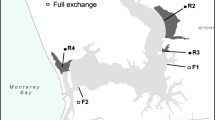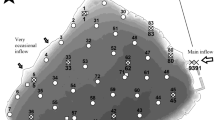Abstract
Seasonally recurrent and persistent hypoxic events in semi-enclosed coastal waters are characterized by bottom-water dissolved oxygen (d.o.) concentrations of < 2.0 ml l−1. Shifts in the distribution patterns of zooplankters in association with these events have been documented, but the mechanisms responsible for these shifts have not been investigated. This study assessed interspecific differences in responses to hypoxia by several species of calanoid copepods common off Turkey Point, Florida, USA: Labidocera aestiva (Wheeler) (a summer/fall species), Acartia tonsa (Dana) (a ubiquitous year-round species), and Centropages hamatus (Lilljeborg) (a winter/spring species). Under conditions of moderate to severe hypoxia 24-h survival experiments were conducted for adults and nauplii of these species from August 1994 to October 1995. Experiments on adults used a flow-through system to maintain constant d.o. concentrations. Adults of A. tonsa showed no decline in survival with d.o. as low as 1.0 ml l−1, sharp declines in survival at d.o. = 0.9 to 0.6 ml l−1, and 100% mortality with d.o. = 0.5 ml l−1. Adults of L. aestiva and C. hamatus were more sensitive to oxygen depletion: both species experienced significant decreases in survival for d.o. = 1.0 ml l−1. Nauplii of L. aestiva and A. tonsa showed no significant mortality with d.o. = 1.1 to 1.5 ml␣l−1 and d.o. = 0.24 to 0.5 ml l−1, respectively. In addition, experiments investigating behavioral avoidance of moderate to severe hypoxia were carried out for adults of all three species. None of the three species effectively avoided either severely hypoxic (d.o. < 0.5 ml l−1) or moderately hypoxic (d.o. ≈ 1.0 ml l−1) bottom layers in stratified columns. These results suggest that in␣nearshore areas where development of zones of d.o. < 1.0 ml l−1 may be sudden, widespread, or unpredictable, patterns of reduced copepod abundance in bottom waters may be due primarily to mortality rather than avoidance.
Similar content being viewed by others
Author information
Authors and Affiliations
Additional information
Received: 31 August 1996 / Accepted: 24 September 1996
Rights and permissions
About this article
Cite this article
Stalder, L., Marcus, N. Zooplankton responses to hypoxia: behavioral patterns and survival of three species of calanoid copepods. Marine Biology 127, 599–607 (1997). https://doi.org/10.1007/s002270050050
Issue Date:
DOI: https://doi.org/10.1007/s002270050050




